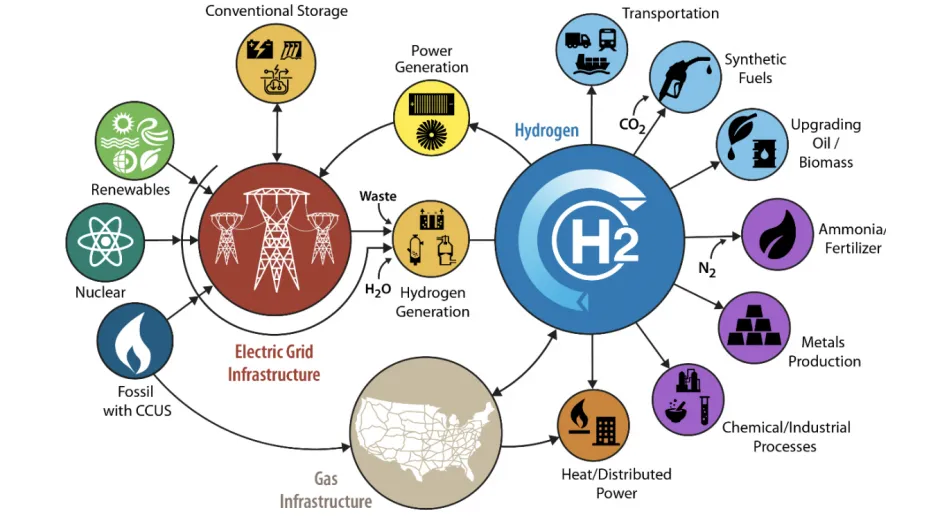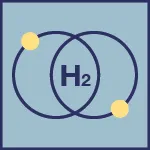Hydrogen Factsheet
Hydrogen Economy
Hydrogen is a feedstock and energy carrier used in multiple sectors of our economy. Globally 90 million metric tons (Mt) of hydrogen were produced and used in 2020, with U.S. production being approximately 10 Mt. Hydrogen is the most abundant element in the universe, but is present in limited amounts in elemental form on Earth. The primary method of producing hydrogen globally and in the U.S. is steam methane reforming (SMR) of natural gas. SMR results in CO₂ emissions, which is problematic from a climate change perspective. Electrolysis is a hydrogen production process that uses electricity to split water into hydrogen and oxygen. This production process can provide a pathway for decarbonizing some sectors of the economy if the electricity is generated from zero- or low-carbon sources such as renewables and nuclear power. Hydrogen can play a key role in decarbonizing end-use applications where other alternatives such as electrification are problematic.1
- Global demand for hydrogen could reach 150 Mt by 2030.3
- Hydrogen has a very low volumetric energy density and is stored as either a high-pressure gas, or low-temperature liquid.4
H2@Scale Diagram2

Hydrogen Technologies and Impacts
Production
- Hydrogen can be produced via several pathways including SMR, electrolysis of water, and gasification of coal or biomass.5
- Color codes have been used to describe hydrogen production pathways. Commonly used colors include grey for SMR, blue for SMR with carbon capture and sequestration (CCS), and green for electrolysis using renewable electricity.6
- In SMR, natural gas is reacted with high temperature steam to produce hydrogen. The resulting synthesis gas also contains CO and CO₂. Using the "water-gas shift reaction" the CO and steam are reacted together over a catalyst producing more hydrogen and CO₂.7
- SMR is the least expensive ($1-2/kgH₂) and widely used method of producing hydrogen.5,8 Currently about 95% of hydrogen in the U.S. is produced using SMR at large central plants.7 Hydrogen produced with SMR emits about 7-10 kgCO₂/kgH₂.9
- The 2020 production cost for green hydrogen is about $7.5/kgH₂. The U.S. Department of Energy (DOE) targets are to lower this to $2/kgH₂ by 2026 and $1/kgH₂ by 2031.2
- Alkaline and proton exchange membrane (PEM) electrolyzers are commercially available, while solid oxide electrolyzer cell (SOEC) and anion exchange membrane (AEM) electrolyzers are maturing.10 In 2019, electrolyzers had a baseline higher heating value conversion efficiency of 71%.11
- The current grid mix is not ideal for electrolysis as around 60% of U.S. electricity is still produced using fossil fuels.12 The CO₂ intensity of hydrogen produced by electrolysis is approximately 20-25 kgCO₂/kgH₂ in the U.S.2
Distribution and Storage
- Hydrogen in the U.S. is produced at, or near, where it will be used, reflecting difficulties with transportation.5
- Hydrogen can be transported to point of use via pipeline, or over the road using liquid tanker, or tube trailer trucks.13
- Pipelines are the least expensive way to deliver hydrogen at a cost $0.2-0.5/kgH₂. There are approximately 1600 miles of pipeline in the U.S.5,14
- Tube trailers can transport compressed hydrogen, typically used over distances of 200 miles or less, but are expensive at $0.9-1.9/kgH₂.5,14
- Liquid tankers are better suited than tube trailers for transporting larger amounts of hydrogen over longer distances, but are more expensive at $2.7-3.2/kgH₂ due to the energy and equipment requirements for the liquefaction process.5,14
- Hydrogen has the highest energy per mass of any fuel at 120 MJ/kgH₂ on a lower heating value basis, but a low volumetric energy density of 8 MJ/l for liquid hydrogen, compared to a volumetric energy density of 32 MJ/l for gasoline.4
- At 1 bar and 25°C, the volumetric energy density of hydrogen is lower than those of gasoline, diesel, jet fuel, and marine bunker fuel by factors of approximately 3200, 3700, 3600, and 4000, respectively.1
- Even as a compressed gas at 700 bar or as a liquid at -253°C the volumetric energy density of hydrogen is 7-8 and 4-5 times lower, respectively, than conventional liquid hydrocarbon fuels at ambient conditions.1
- Using compression or liquefaction, hydrogen can be stored in its pure form as a compressed gas or cryogenic liquid. Liquefaction can achieve greater densities than compressed gas, but is more energy intensive and requires specialized equipment.15
- Hydrogen gas is typically stored at 350 or 700 bar while liquid storage requires cryogenic temperatures since its boiling point is −253°C.
- Underground hydrogen storage may be possible, conventional options include using salt caverns, while proposed methods include abandoned coal mines and refrigerated mined caverns.16
End-Uses
- Petroleum refineries are the largest consumers of hydrogen in the U.S. using about 5.5 Mt annually in 2021. Second to refineries, U.S. ammonia synthesis consumed around 3.5 Mt of hydrogen in 2021.2 Other uses of hydrogen include the production of methanol used in industrial applications and chemical manufacturing, and the reduction of iron ore through direct reduction.
- A variety of hydrocarbon synfuels can be produced by reacting hydrogen with CO₂, making production of synfuels a potential demand for hydrogen. When CO₂ is captured from the atmosphere and used for hydrocarbon synfuel production the carbon in the fuel can be considered net zero in terms of emissions, though there are potentially emissions associated with the CO₂ capture process.18
- Blending hydrogen with natural gas could result in rapid demand increase.18 Preliminary estimates say hydrogen can be injected into natural gas pipelines up to concentrations of 20% by volume, but co-firing with natural gas reduces greenhouse gas emissions only 6-7%.18,19
- Direct reduction of iron (DRI) using hydrogen has potential to replace blast furnace steel production - 47-68 kgH₂/tDRI is estimated to be required in this process.8
- Hydrogen burners are currently under development to replace natural gas and other fossil fuels in high-temperature heat applications. These applications include cement clinker kilns, glass furnaces, aluminum remelting furnaces, metal rolling and heat treatment furnaces.
- Hydrogen can be used in residential buildings to power fuel cell combined heat and power (CHP) systems, direct flame combustion boilers, catalytic boilers, and gas powered heat pumps. Larger district heat and CHP devices using NG could be redesigned for hydrogen.20
- Hydrogen can be used directly or indirectly in conventional and synfuels, in all forms of transportation (road, rail, water, air). Global petroleum refining used 40 Mt H₂ in 2021, which was more than 1000 times the direct use of hydrogen as a transportation fuel. Clean hydrogen is expected to play an important role in decarbonizing heavy-duty transport (road, marine fuels, aviation fuels) by 2050.
- Direct use of electricity in light-duty vehicles is about 3 times more energy efficient than conversion into hydrogen and use in fuel cell vehicles.
- Hydrogen is not well suited for use in light-duty cars and trucks, but may find use in medium- and heavy-duty vehicles that need to store large amounts of energy and refuel rapidly, both of which are challenging for electric vehicles.
Projected Growth in Hydrogen End-Uses in U.S.17 (million metric tons H2 per year)

Environmental Impacts
- Global hydrogen production currently accounts for approximately 1 Gt of CO₂ emissions.
- Electrolysis represents less than 5% of worldwide hydrogen production now, but is a pathway to zero-carbon emissions.20
- On a stoichiometric basis the water consumption required for electrolysis is 9 kgH₂O/kgH₂.22 When accounting for electricity generation, water consumption increases to 15-20 kgH₂O/kgH₂.23
- The water required to produce 800 Mt of hydrogen for a net zero economy in 2050 is much less than what is needed for the extraction and processing of fossil fuels today.23
- Hydrogen production on this scale would account for 0.7% of global freshwater use. Desalination would add approximately $0.02/kg to the price of hydrogen.23
U.S. Hydrogen Strategy and Policy
To bolster development of the hydrogen economy the U.S. the Infrastructure, Investment, and Jobs Act (IIJA) contains $9.5 billion of funding for hydrogen. The Inflation Reduction Act (IRA) contains two provisions that will subsidize clean hydrogen production.24 The U.S. National Clean Hydrogen Strategy and Roadmap from the DOE explores pathways for clean hydrogen to aid in decarbonization goals across the economy.2 The U.S. Department of Transportation Federal Highway Administration designated a national network of electric vehicle charging and hydrogen, propane, and natural gas fueling infrastructure along national highway system corridors.25
Hydrogen Hubs
- The U.S. DOE aims to establish 6-10 regional clean hydrogen hubs across the U.S. through a Regional Clean Hydrogen Hubs Program (H2Hubs). H2Hubs has a $7 billion budget and is part of the larger hydrogen hub program funded by the IIJA with the goal of creating networks of hydrogen producers, consumers, and local connective infrastructure.26
Tax Credits Promoting Hydrogen
- The value of the IRA tax credits (IRC Sec 45V) are determined based on life cycle CO₂e emissions per kg of hydrogen produced. The IRA also increases the rate of an existing tax credit for carbon sequestration (IRC Sec 45Q) that cannot be combined with 45V.24
IRA Hydrogen Investment Tax Credit and Production Tax Credit24

Center for Sustainable Systems, University of Michigan. 2023. “Hydrogen Factsheet.” Pub. No. CSS23-07.
References
- Center for Sustainable Systems (CSS) (2022) MI Hydrogen Roadmap Workshop Report.
- U.S. Department of Energy (DOE) U.S. National Clean Energy Strategy and Roadmap.
- International Energy Agency (IEA) (2023) Hydrogen.
- U.S. DOE Hydrogen Storage.
- U.S. DOE Hydrogen Production and Distribution.
- U.S. Energy Information Administration (EIA) (2022) Hydrogen explained Production of hydrogen.
- U.S. DOE Hydrogen Production: Natural Gas Reforming.
- IEA (2019) The Future of Hydrogen.
- Sun, P., et al. (2019) Criteria Air Pollutants and Greenhouse Gas Emissions from Hydrogen Production in U.S. Steam Methane Reforming Facilities. Environ. Sci. Technol. 2019, 53, 12, 7103–7113.
- IEA (2022) Electrolysers Technology deep dive.
- Peterson, D., et al (2020) Hydrogen Production Cost From PEM Electrolysis - 2019.
- U.S. EIA (2023) Annual Energy Outlook 2023.
- U.S. DOE Hydrogen Delivery.
- U.S. DOE Pathways to Commercial Liftoff: Clean Hydrogen.
- Dalebrook, A., et al (2013) Hydrogen storage: beyond conventional methods. Chem. Commun., 2013,49, 8735-8751.
- Muhammad, N., et al (2021) A review on underground storage: Insight into geological sites, influencing factors and future outlook. Energy Reports, Volume 8, 461-499.
- U.S. DOE (2023) U.S. Clean Hydrogen Strategy and Roadmap at a Glance.
- Elgowainy, A., et al. (2020) Assessment of Potential Future Demands for Hydrogen in the United States.
- Baldwin, S., et al (2022) Assessing the Viability of Hydrogen Proposals: Considerations for State Utility Regulators and Policymakers.
- Dobbs, P., et al (2014) Hydrogen and fuel cell technologies for heating a review. International Journal of Hydrogen Energy, Volume 40, Issue 5, 2065-2083.
- Osman, A., et al (2022) Hydrogen production, storage, utilization and environmental impacts: a review. Environmental Chemistry Letters, 20, 153-188.
- Beswick, R., et al. (2021) Does the Green Hydrogen Economy Have a Water Problem. CS Energy Lett. 2021, 6, 9, 3167–3169.
- Energy Transitions Commission (2021) Making the Hydrogen Economy Possible: Accelerating Clean Hydrogen in an Electrified Economy.
- Resources for the Future (2022) Incentives for Clean Hydrogen Production in the Inflation Reduction Act.
- U.S. DOE (2021) National Alternative Fuels Corridors.
- U.S. DOE Regional Clean Energy Hubs.
